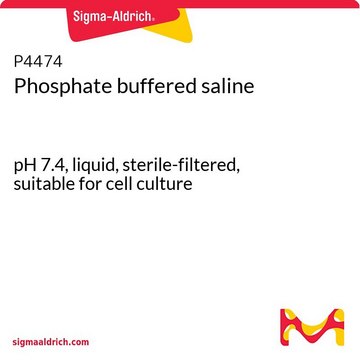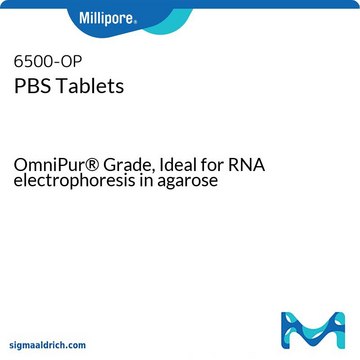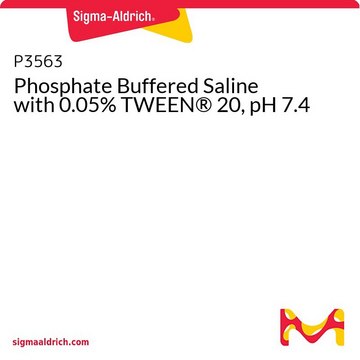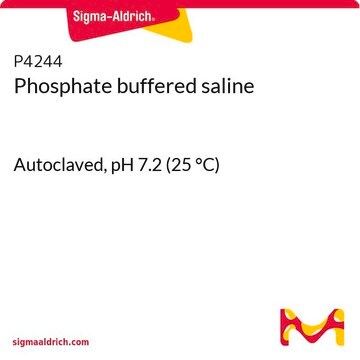P4417
Phosphate buffered saline
tablet, pH 7.2-7.6 (1 tablet/200 mL)
Synonim(y):
PBS
About This Item
Polecane produkty
product name
Phosphate buffered saline, tablet
Postać
tablet
Poziom jakości
warunki przechowywania
dry at room temperature
kolor
white
pH
7.2-7.6 (1 tablet/200 mL)
rozpuszczalność
water: soluble
gęstość
1.02 g/cm3 at 20—25 °C
1.03 g/cm3 at 20—25 °C
Zastosowanie
diagnostic assay manufacturing
histology
life science and biopharma
Szukasz podobnych produktów? Odwiedź Przewodnik dotyczący porównywania produktów
Powiązane kategorie
Opis ogólny
Expanding beyond cell biology, PBS demonstrates versatility in applications such as creating custom ELISA buffers for optimal antibody-antigen interactions. Moreover, it serves as a proficient running buffer for Protein A/G chromatography, facilitating antibody purification based on specific antigen binding. In hematological and biochemical procedures, PBS plays a pivotal role in the effective washing of cells and tissues. In summary, PBS stands out as an indispensable tool in both biological and biochemical research, offering isotonicity, buffering capacity, simplicity, and stability. Its diverse applications in cell biology, reagent preparation, protein purification, and various biological assays underscore its profound significance in advancing scientific knowledge and understanding.
Zastosowanie
- for the production of platinum nanoparticles (NP-Pt) hydrocolloids
- for the washing of blood sample and SEM (scanning electron microscope) stubs prior to SEM
- for preparing the solution of fluorescent lectin wheat germ agglutinin (WGA)
- for the dilution of capture antibody during ELISA (enzyme linked immunosorbent assay)
- for suspension of cell pellets during centrifugation
- in immunoassay procedures
Cechy i korzyści
- High-quality product suitable for multiple research applications
- Can be used as a buffer component in biological and biochemical applications
- Highly soluble in water
Rekonstytucja
Inne uwagi
najczęściej kupowane z tym produktem
polecane
Kod klasy składowania
13 - Non Combustible Solids
Klasa zagrożenia wodnego (WGK)
WGK 1
Temperatura zapłonu (°F)
Not applicable
Temperatura zapłonu (°C)
Not applicable
Certyfikaty analizy (CoA)
Poszukaj Certyfikaty analizy (CoA), wpisując numer partii/serii produktów. Numery serii i partii można znaleźć na etykiecie produktu po słowach „seria” lub „partia”.
Masz już ten produkt?
Dokumenty związane z niedawno zakupionymi produktami zostały zamieszczone w Bibliotece dokumentów.
Klienci oglądali również te produkty
Protokoły
Antibody Purification using Protein A, Protein G, or Protein L Agarose protocol is designed as a quick purification method for antibodies from mammalian sera, ascites, and cell culture supernatants. It should be noted that if the starting material is serum or ascites the final preparation will contain endogenous host IgG as well as specific antibodies. In general, the presence of this endogenous IgG should not interfere with assays using the antibodies.
Protokoły oczyszczania przeciwciał dają preparaty zawierające endogenne IgG wraz ze specyficznymi przeciwciałami.
Cell staining can be divided into four steps: cell preparation, fixation, application of antibody, and evaluation.
ELISA protocols providing detailed instructions on performing indirect ELISA and Capture ELISA . Learn more about recommended products and techniques for performing both sandwich ELISA and indirect ELISA experiments.
Nasz zespół naukowców ma doświadczenie we wszystkich obszarach badań, w tym w naukach przyrodniczych, materiałoznawstwie, syntezie chemicznej, chromatografii, analityce i wielu innych dziedzinach.
Skontaktuj się z zespołem ds. pomocy technicznej









